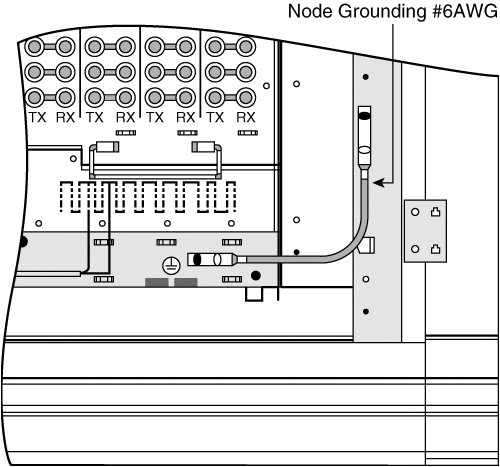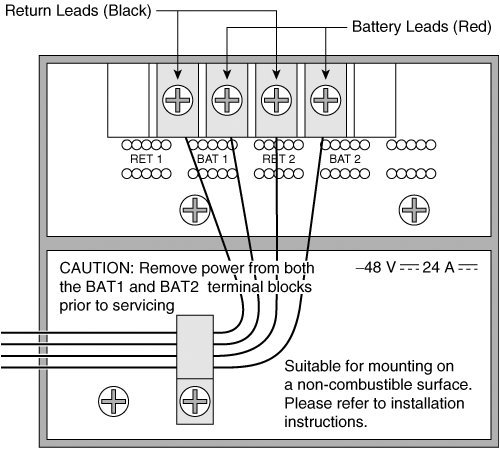Turning Up the ONS 15454
| This section explains how to provision and turn up a Cisco ONS 15454 for service, including assigning the node name, date and time, timing references, and network information, such as the Internet Protocol (IP) address, subnet mask, default router, users and security levels, and interface module protection groups. This section discusses how to install the shelf and external cables to the backplane, install interface modules, and connect a PC and log into the ONS 15454 using the GUI called CTC. Installing and Powering the ShelfThe Cisco ONS 15454 comes shipped from the factory in a sturdy, well-protected cardboard box. In the top of the larger box is a smaller box that contains miscellaneous installation material, including various tie-wraps, screws, instruction manuals, mounting studs, plastic fiber/cable-routing guides, and an access tool. To install the ONS 15454 shelf, you need to install the two mounting studs from the miscellaneous installation material into holes in the rack or bay. These studs can be installed in two ways: You can hang the ONS shelf from them, or they can be used to support the weight of the shelf while you are installing the shelf-mounting screws. To power the ONS 15454 shelf, you first need to ensure that the office ground has been installed at the top of the bay or frame, according to local electrical specifications. Then, to install the frame ground from the ONS shelf to the frame or bay, make up the grounding cable using a length of #6 AWG stranded copper wire and two double-hole compression lugs. After this, you attach one end of the frame ground wire to the back of the frame or bay, and attach the other end to the studs marked "Frame Ground," under the plastic cover on the lower-right side of the ONS shelf. Figure 12-1 illustrates ONS 15454 frame-grounding example. Figure 12-1. ONS 15454 Frame-Grounding Example To connect the DC power to the ONS shelf, you use #10 AWG stranded copper wire (red and black) and determine the source of the DC power. The source could be a fuse and alarm panel, a battery distribution fuse bay (BDFB), or, in some cases, the DC output of a small rectifier. The ONS shelf has a DC terminal strip in the lower-left corner of the back of the shelf. This strip supports two DC power connections (redundant); each set is labeled as Bat 1, Ret 1 and Bat 2, Ret 2. Figure 12-2 shows ONS 15454 DC power connections. Figure 12-2. ONS 15454 DC Power Connections Using a red wire for Bat 1 and a black wire for Ret 1, connect the Bat 1 and Ret 1 of the ONS shelf to the same terminal designations on the source. If a redundant power feed is desired, repeat this for Bat 2 and Ret 2, using a second set of red and black wires. Use a voltmeter to verify that the voltages for both A and B battery are between 42 VDC (volts, direct current) and 57 VDC. Initial ConfigurationThe ONS 15454 turns up in an initial configuration as a unidirectional path-switched ring (UPSR) node. It has a default IP address and subnet mask, a target identifier, date, time, and time zone. It also has a default timing configuration. All the service interface modules (when installed) initially are working or active, without any modules assigned as protect or standby. The individual assigned to the provisioning of the system must make the proper changes to all the appropriate parameters. This process is usually controlled by an engineering or information technology (IT) group that assigns the appropriate parameters and slot assignments for all interface modules. Detailed shelf turn-up procedures can be found in the ONS 15454 documentation located at http://www.cisco.com/en/US/products/hw/optical/ps2006/tsd_products_support_series_home.html. Installing Common Equipment CardsThe common equipment cards (interface modules) consist of the cards in Slots 7, 8, 9, 10, and 11. Slots 7 and 11 contain the timing communication and control cards; one is active and the other is standby. Slots 8 and 10 contain the cross-connect cards, either the XCVT, XC10G, or XC10GVX, depending on the application and assignment by engineering or IT documentation. One module is active, and the other is standby. Slot 9 contains the Alarm Interface Card (AIC). This card is used for providing housekeeping alarm contact interfaces to an external alarm-polling system located in an unmanned location. An example of a housekeeping alarm might be a commercial power failure or an open door. The procedure for installing the common equipment cards is described in the installation and turn-up practices of the ONS 15454, which is located at www.cisco.com/en/US/products/hw/optical/ps2006/tsd_products_support_series_home.html. Timing Communications and Control CardThe Advanced Timing Communications and Control (TCC2) card performs system initialization, provisioning, alarm reporting, maintenance, diagnostics, Internet Protocol (IP) address detection/resolution, SONET section overhead (SOH) data communication channel/generic communication channel (DCC/GCC) termination, and system fault detection for the ONS 15454. The TCC2 also ensures that the system maintains Stratum 3 (Telcordia GR-253-CORE) timing requirements. It monitors the supply voltage of the system. The TCC2 card can be either active or standby, which means that there are two TCC2 cards in the ONS shelf in Slots 7 and 11. The TCC2 card can be installed in either Slot 7 or Slot 11 by unlocking the extractors on the top and bottom edges of the card, sliding the card into Slot 7 or Slot 11, fully seating the card in the slot, and then closing the extractors to lock the card into the slot. When the TCC2 card is in the slot, the light emitting diodes (LEDs) on the face of the card begin to blink and flash in the following sequence of events:
The second TCC2 card can be installed at this time using the same method as with the first card. The LEDs on the second card also perform the same sequence as the first TCC2 card. Cross-Connect Card (XCVT/XC10G/XC-VXC-10G)The XCVT card establishes cross-connections at the STS-1 and VT levels. The XCVT provides nonblocking STS-48 capacity to Slots 5, 6, 12, and 13, and nonbidirectional blocking STS-12 capacity to Slots 1 to 5 and 14 to 17. Any STS-1 on any port can be connected to any other port, meaning that the STS cross-connections are nonblocking. The XC10G card cross-connects STS-1, STS-12, STS-48, and STS-192 signal rates, as well as concatenated signal rates of STS-3c, 6c, 9c, 12c, 24c, 48c, and 192c. The XC10G allows up to four times the bandwidth of current XCVT cards (used for OC-3, OC-12, and OC-48 systems). The XC10G provides a maximum of 1152 STS-1 cross-connections. Any STS-1 on any port can be connected to any other port, meaning that the STS cross-connections are nonblocking. The XC-VXC-10G card establishes connections at the STS and VT levels. The XC-VXC-10G provides STS-192 capacity to Slots 5, 6, 12, and 13, and STS-48 capacity to Slots 1 to 4 and 14 to 17. Any STS-1 on any port can be connected to any other port, meaning that the STS cross-connections are nonblocking. The XCVT/XC10G/XC-VXC-10G can be installed using the extractors, as described in the TCC2 section, in Slots 8 and 10, which also provides an active standby arrangement. When the cross-connect card is in the slot, the LEDs on the face of the card begin to blink and flash in the following sequence of events:
Alarm Interface Controller-International (Optional)The optional Alarm Interface ControllerInternational (AIC-I) card provides customer-defined alarm input/output (I/O) and supports user data and local and express orderwire. It provides 12 customer-defined input and 4 customer-defined input/output contacts. The physical connections are through the backplane wire-wrap pin terminals. A power-monitoring function monitors the supply voltage (48 VDC) for the ONS shelf. This card is optional and typically is installed only when "housekeeping" alarms are required to be transported across the network to an alarm center or network operations center (NOC). Housekeeping alarms are usually associated with alarms or events that are external to the MSPP system. Examples of these types of alarms or events are open doors, high temperatures, a commercial power failure, and so on. Optical and Electrical Interface ModulesThe various types of optical or electrical interface modules can be installed in the system as determined by documentation from engineering or IT. These interface modules can be assigned to service Slots 1 to 6 or 12 to 17 of the ONS 15454 shelf. Installing these modules at this time facilitates the assignment of system turn-up parameters associated with synchronization or DCCs, mentioned later in this chapter. General Network Element InformationWhen all the common cards are installed and the appropriate LEDs are lit, you can begin to provision the ONS 15454 shelf. To begin the provisioning process or turn-up of the ONS 15454, you must have some general information for each network element (NE) or shelf in a network. This information usually can be provided by a engineering or IT group and consists of the following:
You also need to know the network requirements:
You also need to know the types of services in the system, such as the DS3, DS1, OCN, and so on. You need to know how the protection groups will be assigned as well. ONS 15454 provides protection to interface modules and ports of interface modules with protection groups. This gives added value to a module or port that might be providing service (such as DS-3 or OC-N). Providing protection is often a billable item to a customer who needs a reliable circuit or service. This means that a customer who subscribes to a protected service will have a "working" circuit and a "protect" circuit, in case the working circuit fails for some reason. All interfaces of the ONS 15454 can be either protected or unprotected. Protection groups are assigned as 1:1 or 1:N for electrical interfaces, and 1+1 for optical interfaces. When you assign protection groups, you assign a protect interface module to a single working interface module, as in a 1:1 relationship, or to multiple working interface modules, as in a 1:N relationship with N being 1 to 5. In the case of assigning protection groups to optical interface modules, the option choice is 1+1. Optical interface modules can also be provisioned as UPSR or BLSR, but this process isn't a part of assigning protection groups. Optical interfaces are defaulted as UPSR. If the optical interfaces need to be configured as bidirectional line switch ring (BLSR), a user-friendly feature of CTC called the BLSR Wizard is used to create a BLSR from a UPSR. Creating a UPSR or BLSR is a separate task that uses the individual network elements (NE) that have been provisioned and connected with other NEs using fiber-optic cable to form a ring or network. The Cisco ONS 15454 is provisioned using a GUI-based tool that is typically loaded onto a PC. CTC is a preloaded software package GUI that is factory installed on the TCC2. A Java Runtime Environment (JRE) file and an online help file are on a CD and must be loaded onto a PC; then an Internet browser can be used to access CTC on the TCC2 card. Each TCC2 card comes from the factory with a default IP address (192.1.0.2) and a default subnet mask of 255.255.255.0. Each network element must be provisioned with a unique IP address, to avoid IP address conflicts in the network. Set the IP address of the network interface connection (NIC) in the PC to be associated with the same network as the TCC2 card address. The NIC of the PC is connected to the local-area network (LAN) port on the TCC2 card using a Category 5 (CAT 5) straight LAN cable with RJ-45 connectors. You can then launch an Internet browser, which uses the JRE file to connect to the CTC GUI on the TCC2 card. Then a CTC login window appears. The TCC2 card comes from the factory with a default username and password. These are provided in the "Detailed Procedures" section in the Cisco documentation, located at www.cisco.com/en/US/products/hw/optical/ps2006/tsd_products_support_series_home.html. At the CTC login window, the user will fill in the spaces for username and password and select the Login button, as shown in Figure 12-3. Figure 12-3. Cisco Transport Controller Login Window This connects the user to the ONS 15454 shelf and the TCC2 card in the shelf, revealing a graphical representation of the ONS 15454 MSPP shelf and all cards installed in the shelf, as shown in Figure 12-4. Figure 12-4. Cisco Transport Controller Shelf View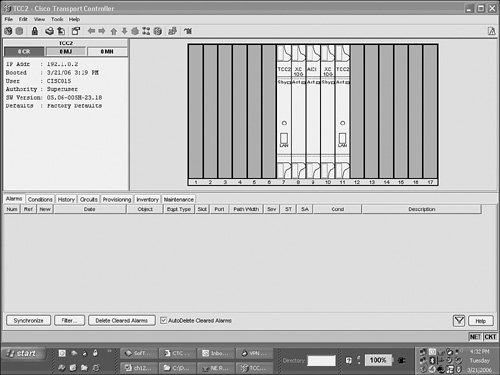 IP AddressingWhen you have logged into the ONS 15454 and you have a GUI representation of the shelf, notice that you have various tabs across the top of this section and down the left side of the lower half of the window. If you use the computer mouse to select one of the tabs across the top of this section, you will notice that the tabs on the left side also change. By selecting the various tabs, you change the lower half of the window, which enables you to set and change the various parameters of the ONS shelf. To change the network settings from the default settings to those assigned by your network administrator, select the Provisioning tab and the Network tab. These selections change the lower half of the window to show various fields that can be changed. The basic network information, provided by the network administrator, consists of the IP address, the subnet mask, and possibly the default router. After you change these options, click the Apply button, and answer Yes to the confirmation response, both of the TCC2 cards reboot individually, and you are logged off the shelf. You must reset the NIC on your PC to match the new network information that you set for the shelfthat is, the IP address, subnet mask, and default router. After these are reset, launch the browser and log in to the shelf for additional provisioning options, such as general information, security, synchronization, and DCC. ONS 15454s can be connected in many different ways within an IP environment, including these:
General node information can be provisioned by selecting the Provisioning tab and the General tab on the window. This changes the window to display various fields to be changed. This is the window used to provision the node name or target identifier (TID), description of the node, latitude and longitude, date, time, time zone, daylight saving time, contact information, and NTP/SNTP choice, as shown in Figure 12-5. Figure 12-5. CTC Shelf View General Tab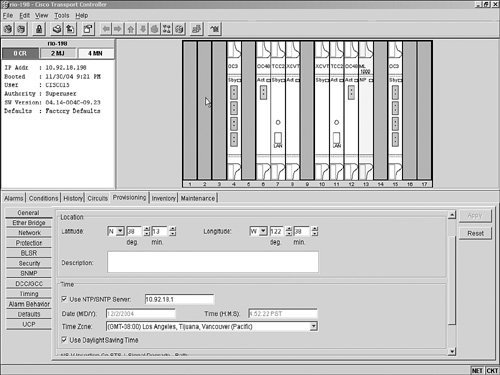 Security and UsersThe CISCO15 ID (Superuser) is provided with the ONS 15454 system, but this user ID is not prompted when you sign into CTC. This ID can be used to set up other ONS 15454 users. You can have up to 500 user IDs on one ONS 15454. Each CTC or TL1 user can be assigned one of the following security levels:
By default, multiple users can log into a node using the same user ID. However, you can provision the node to allow only a single login per user and prevent concurrent logins for all users. To provision users and security, select the Provisioning tab and the Security tab in the window. This opens a window for Security that enables you to provision new users and their security levels, as shown in Figure 12-6. Figure 12-6. CTC Shelf View Security/Users Tab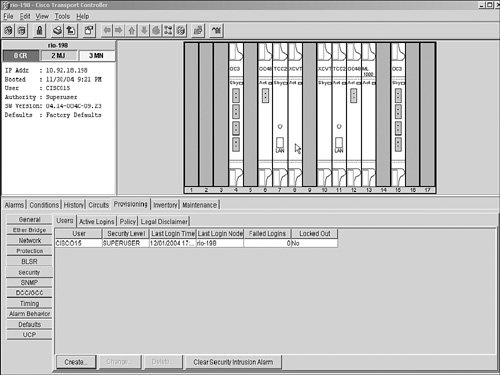 Selecting the Users tab at the top opens a window that shows the current users. Clicking the Create button in the lower-left corner of the window opens a Create User window, as shown in Figure 12-7. Input the information for the User Name, Password, Confirm Password, and Security Level fields, and then click the OK button to confirm the selections. DCCSONET provides four DCCs for network element operation, administration, maintenance, and provisioning: one on the SONET Section layer (D1 to D3 bytes) and three on the SONET Line layer (D4 to D12 bytes). The ONS 15454 uses the Section Data Communications Channel (SDCC) for ONS 15454 management and provisioning. Figure 12-7. CTC Create New User Window The ONS 15454 uses the DCC to transport information about operation, administration, maintenance, and provisioning (OAM&P) over a SONET interface. You can locate DCCs in the SDCC or Line DCC (LDCC). Unused SDCCs and LDCCs can be used to tunnel DCCs from third-party equipment across ONS 15454 networks. A SONET link that carries payload from an ONS 15454 node to a third-party SONET node also has an SDCC defined in the Section overhead. However, the third-party node does not recognize OAM&P messages, and the SDCC should not be enabled. Disabling the SDCC has no effect on the DS3, DS1, and other payload signals carried between nodes. To provision DCC on the ONS 15454, select the Provisioning tab and the DCC/GCC in the window. This opens a window to enable you to provision the DCCs for as many SONET interfaces as needed, as shown in Figure 12-8. Figure 12-8. CTC Shelf ViewDCC Terminations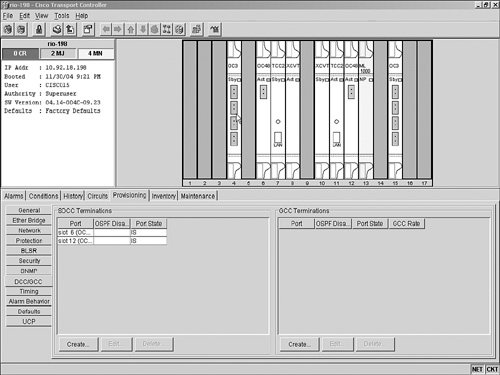 Clicking the Create button opens a new window, which shows a list of all the SONET interfaces that have the capability to have the DCC provisioned and placed in service, as shown in Figure 12-9. Figure 12-9. CTC Create DCC Window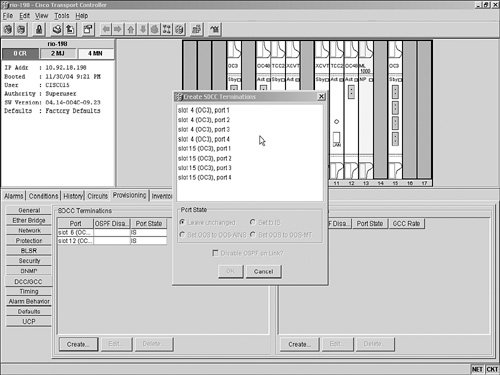 Synchronization and TimingNetwork synchronization and timing are critical elements within a SONET network. The goal is to create a fully synchronous optical hierarchy by ensuring that all ONS 15454 nodes derive timing traceable to a primary reference source (PRS). An ONS 15454 network can use more than one PRS. A PRS is equipment that provides a timing signal whose long-term accuracy is maintained at 1011 or better with verification to Universal Time Coordinated (UTC), and whose timing signal is used as the basis of reference for the control of other clocks within a network. Standards define a primary reference source as one with a frequency offset of less than 1 x 1011 (ITU-T G.811 and ANSI T1.101). A Stratum 1 timing source is typically the PRS within a network. Other types of clocks used in the synchronized network include stratum 2, 3, and 4. In most cases, these clocks are components of a digital synchronization network and are synchronized to other clocks within that network using a hierarchical master-slave arrangement. The clocks used to synchronize ONS 15454 nodes must be Stratum 3 (or better quality) to meet ANSI T1.101 synchronization requirements. Note What is ANSI? The American National Standards Institute (ANSI) is a voluntary membership organization, run with private funding, that develops national consensus standards for a wide variety of devices and procedures. In the United States, a Building Integrated Timing Supply (BITS) clock is commonly used to distribute timing signals from Stratum clocks to an ONS 15454 node. BITS timing references run over the working and protect SONET paths. Local cesium clocks (often referred to as atomic clocks) can also be used to provide Stratum 1quality synchronization. The advantage of a cesium clock is that it never needs recalibration. However, the cost for each unit is very high. Compared to cesium clocks, the Navstart Global Positioning Satellites provide a lower-cost alternative source for network synchronization. These satellites are accessible throughout North America and have internal cesium clocks that can be used as a Stratum 1 source. A Global Positioning System (GPS) receiver costs much less than a cesium clock. The Cisco ONS 15454 is designed to operate in networks compliant with the Telcordia GR-253-CORE and GR-436-CORE. Timing guidelines for the ONS 15454 evolve around the following conditions:
Timing and synchronization in the ONS 15454 are controlled by the TCC, which is Stratum 3compliant. A redundant architecture protects against failure or removal of one TCC card. For timing reliability, the TCC card selects either a recovered clock, a BITS clock, or an internal stratum as the system timing reference. You can provision any of the clock inputs as primary or secondary timing sources. If you identify two timing references, the secondary reference provides protection. A slow-reference tracking loop allows the TCC to track the selected timing reference, synchronize to the recovered clock, and provide holdover in case the reference is lost. In a failover scenario, selection of the next timing reference is governed by the availability of the next-best (clock quality) timing reference, as defined by the stratum hierarchy (discussed in the next section). The timing modes available on the ONS 15454 include the following:
The external timing input signal on the Cisco ONS 15454 must come from a synchronization source whose timing characteristics are better than the Stratum 3 internal clock. The TCC tracks the external reference with the internal clock. The BITS signal is a DS-1 level, 1.544-MHz signal, formatted either as Superframe (SF), which contains 12 frames per superframe, or Extended Superframe (ESF), which contains 24 frames per superframe. For the ONS 15454, the default setting for the BITS framing reference is ESF. The ONS 15454 can accept reference timing from any optical port. For increased reliability, optical cards with multiple ports (such as four-port OC-3) can have only one of its ports provisioned as a timing reference. The optical cards divide the recovered clock to 19.44 MHz and transmit it to the active and standby TCC2 cards, where it is qualified for use as a timing reference. Synchronization status messaging (SSM) can be optionally enabled or disabled on an optical port. A controller on the optical card monitors the received SSM and reports any changes to the TCC synchronization process. If an optical port (receiver) is selected as the active timing reference, the SSM value DUS (Don't Use for Synchronization) is transmitted (on the transmit port) to help prevent timing loops. If SSM is disabled, the controller does not monitor the received SSM value and transmits the SSM value STU (Synchronized, Traceability Unknown). Mixed-mode timing enables you to select both external- and line-timing sources. However, Cisco does not recommend its use because it can create timing loops. Caution must be used when using mixed-mode timing because it can result in inadvertent timing loops. The most common reason for using mixed-mode timing is so that an OC-N timing source can be provisioned as a backup for the BITS timing source. The ONS 15454 is considered to be in free-running state when it is operating on its own internal clock. The ONS 15454 has an internal clock in the TCC that is used to track a higher-quality reference or, in case of node isolation, provide holdover timing or a free-running clock source. The internal clock is a certified stratum clock with enhanced capabilities that match the Stratum 3E specifications. To provision the timing of the ONS 15454, select the Provisioning tab and the Timing tab in the window. This opens a new window to allow provisioning of the timing parameters, as shown in Figure 12-10. Figure 12-10. CTC Shelf View-Synchronization Tab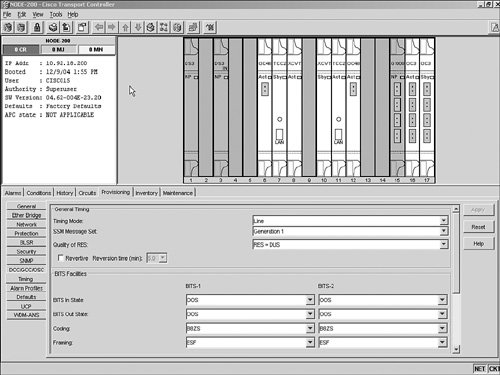 Connecting the OpticsEnsure that the optical cards have been installed in the appropriate slot in the ONS 15454 shelf. The cards automatically are turned up, and the associated ports, Transmit and Receive, are automatically placed in the OOS-AINS (Out of ServiceAutomatic in Service state). The fiber jumpers should be thoroughly cleaned, using an optical fibercleaning kit, and tested for the proper output and receive levels, using an optical power meter. Connect the assigned fiber jumpers from the optical connectors on the optical card ports to the optical connectors in the fiber patch panel or the LGX (Light Guide Cross-connect) panel. The fiber jumpers should be connected as indicated in the Cisco installation documentation for the particular configuration or topology required. These topologies are unidirectional path-switched ring (UPSR), bidirectional line switch ring (BLSR), 2-fiber BLSR and 4-fiber BLSR, terminal (which is some times referred to as PT to PT point to point, linear (add/drop multiplexer) ADM, and path-protected mesh networks (PPMN). Final ConfigurationWhen the ONS 15454 is initially turned up, the default topology is UPSR. After all the nodes on the network have been provisioned and connected with fiber cable and DCCs turned on, you can keep the UPSR topology or change it to either BLSR or terminal. Cisco documentation includes procedures to guide you through changing topologies. Simply put, after the network is completely provisioned and the fibers are connected, you should be able to log into the shelf (node) that you've turned up and view the shelf configuration with CTC. Then click the Network View button of CTC, as shown in Figure 12-11. Figure 12-11. CTC Toolbar Network View Button The Network view of CTC shows all the nodes that make up the network you built, whether that is 2 nodes or 16 nodes. If all the nodes have been provisioned and connected with fiber cable and the DCCs have been turned on, you will see all of your nodes. A network with no alarms shows all green nodes as well as the fiber links connecting them, as shown in Figure 12-12. Figure 12-12. CTC Network View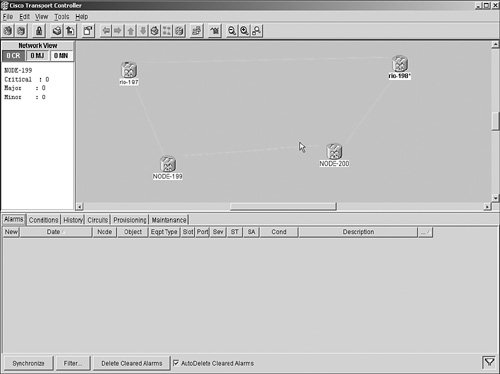 If you don't see all the nodes in the network, you must retrace your turn-up provisioning procedures of the nodes in question. Click the Alarm tab to make certain there are no existing alarms in any of the nodes on the network. Then click the Conditions tab and make certain there are no existing conditions. |
EAN: 2147483647
Pages: 140
